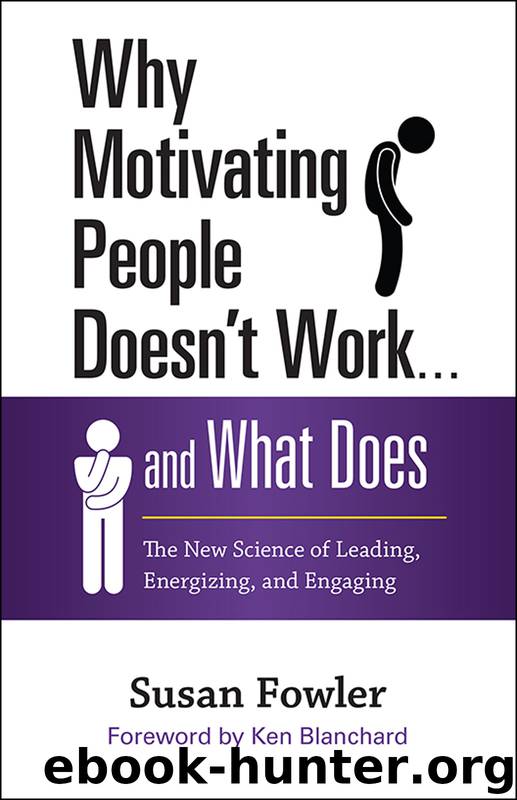Why Motivating People Doesn't Work . . . and What Does by Susan Fowler

Author:Susan Fowler
Language: eng
Format: epub
Publisher: Berrett-Koehler Publishers
Published: 2014-10-14T16:00:00+00:00
Trust the process
Follow the three skills for activating optimal motivation as guidelines. Remember this caveat—if you cannot practice the skills of activating optimal motivation for yourself, it is unlikely you will succeed in activating them with others.
• Facilitate skill 1: Identify the person’s current motivational outlook—Get permission to explore the individual’s feelings regarding her task, goal, or situation.
• Does she have a positive sense of well-being or not? Listen to clues in her language; watch her nonverbal body language. (Does she use phrases such as “I have to” or “I get to”? Does she appear defeated, defiant, and defensive or inspired and joyful?)
• Is the individual experiencing a low quality or high quality of psychological needs? (Does this person feel in control and recognize she has choices, feel supported and have a sense of purpose regarding the situation, and feel she has the ability to navigate the challenges posed by the situation?)
• Is the individual demonstrating low- or high-quality self-regulation? (Is this person practicing mindfulness, making a values-based decision, or connecting the situation to a higher purpose?)
• Is the individual’s motivational outlook suboptimal (disinterested, external, or imposed) or optimal (aligned, integrated, or inherent)?
• Facilitate skill 2: Shift to (or maintain) an optimal motivational outlook—Perhaps the simplest and most direct way to help the individual appreciate his options is to refer to the Spectrum of Motivation model and explore potential upsides and downsides for shifting to a more optimal motivational outlook.
That shift is most likely to happen through high-quality self-regulation. As a leader, you can facilitate this process through the MVPs:
• Promote the individual’s practice of mindfulness. First, ask for permission to pursue the Power of Why technique. Then as you and the individual discuss the situation, ask a series of questions such as, Why is that important to you? Why do you think that is true for you? Why is that? The question why helps individuals process their situation at a higher level, peeling back layers of distractions that block their awareness of or a link to their psychological needs.
• Help the individual align the situation with his workplace values. If it hasn’t happened in previous sessions, take the time now to help the individual develop workplace values. Ask open-ended questions, recognizing and acknowledging his feelings and emotions. Ultimately, the question you want to ask is, Do you see any alignment between your values and this situation?
• Help the individual connect the situation to a noble purpose. As with values, if an individual does not have a sense of the purpose of his role, how he contributes to a greater good, or how he serves a higher cause, this is a good time to have the conversation. People will rarely experience an integrated motivational outlook without having a deeply felt, overarching reason that gives meaning to the role they play in a bigger context of work and life.
• Facilitate skill 3: Reflect—Guide the individual through a reflection on the outlook conversation experience. What was helpful, awkward, challenging, and enlightening? If the individual experienced a shift to an optimal motivational outlook, inquire how she feels.
Download
This site does not store any files on its server. We only index and link to content provided by other sites. Please contact the content providers to delete copyright contents if any and email us, we'll remove relevant links or contents immediately.
Hit Refresh by Satya Nadella(8338)
The Compound Effect by Darren Hardy(7555)
Change Your Questions, Change Your Life by Marilee Adams(6640)
Nudge - Improving Decisions about Health, Wealth, and Happiness by Thaler Sunstein(6633)
The Black Swan by Nassim Nicholas Taleb(6190)
Daring Greatly by Brene Brown(5639)
Deep Work by Cal Newport(5462)
Principles: Life and Work by Ray Dalio(5321)
Rich Dad Poor Dad by Robert T. Kiyosaki(5147)
The Myth of the Strong Leader by Archie Brown(4789)
Man-made Catastrophes and Risk Information Concealment by Dmitry Chernov & Didier Sornette(4735)
Big Magic: Creative Living Beyond Fear by Elizabeth Gilbert(4723)
The Slight Edge by Jeff Olson(4722)
Discipline Equals Freedom by Jocko Willink(4634)
Digital Minimalism by Cal Newport;(4540)
The Motivation Myth by Jeff Haden(4524)
Stone's Rules by Roger Stone(4415)
Management Strategies for the Cloud Revolution: How Cloud Computing Is Transforming Business and Why You Can't Afford to Be Left Behind by Charles Babcock(4130)
The Doodle Revolution by Sunni Brown(4042)
